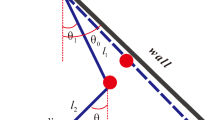Abstract
Pendulums and similar systems, such as links of chains, bodies hanging on ropes, kinematic chains forming working parts of manipulators, and robotic devices, are frequently used in industrial applications. They often cooperate in tubes or working spaces limited by walls or other rigid obstacles. This was the inspiration to carry out this study on the influence of impacts on the behaviour of a chain-like system represented by a double pendulum moving between two vertical walls. The simulations were performed for a specified extent of excitation frequencies. The results indicate a number of bifurcations that change the character of the induced motion to regular, quasi-periodic, and chaotic in the individual frequency subintervals.
















Similar content being viewed by others
References
Cross, R.: A double pendulum model of tennis strokes. Am. J. Phys. 79(5), 470–476 (2011)
Egger, P., Caracoglia, L.: Analytical and experimental investigation on a multiple-mass-element pendulum impact damper for vibration mitigation. J. Sound Vibration 353, 38–57 (2015)
Gottwald, G., Melbourne, I.: A new test for chaos in deterministic systems. Proc. R. Soc. Lond. A 460, 603–611 (2004)
Gottwald, G., Melbourne, I.: On the implementation of the 0–1 test for chaos. SIAM J. Appl. Dyn. Syst. 8, 129–145 (2009)
Gugan, D.: Inelastic collision and the Hertz theory of impact. Am. J. Phys. 68(10), 920–924 (2000)
Gumus, E., Ertas, A.: Analysis of free pendulum vibration absorber using flexible multi-body dynamics. Shock Vibration 2016, 19 (2016)
Heagy, J.F., Platt, N., Hammel, S.M.: Characterization of on–off intermittency. Phys. Rev. E 49(2), 1140–1150 (1994)
Lampart, M., Zapoměl, J.: Vibrations attenuation of a system excited by unbalance and the ground movement by an impact element. Appl. Math. Nonlinear Sci. 1(2), 603–616 (2016). https://doi.org/10.21042/AMNS.2016.2.00046
Lampart, M., Zapoměl, J.: Dynamical properties of a nonautonomous double pendulum model. Math. Methods Appl. Sci. 41(17), 7106–7114 (2018). https://doi.org/10.1002/mma.4650
Lenci, S., Pavlovskaia, E., Rega, G., Wiercigroch, M.: Rotating solutions and stability of parametric pendulum by perturbation method. J. Sound Vibration 310(1–2), 243–259 (2008)
Mahmoudkhani, S.: Improving the performance of auto-parametric pendulum absorbers by means of a flexural beam. J. Sound Vibration 425, 102–123 (2018)
Martinovič, T.: Chaos01: 0–1 Test for Chaos. R Package Version 1.1.1 (2016) https://CRAN.R-project.org/package=Chaos01
Matlab, The MathWorks, Inc., Natick, Massachusetts, United States (2015b)
Platt, N., Spiegel, E.A., Tresser, C.: On-off intermittency: a mechanism for bursting. Phys. Rev. Lett. 70(3), 279–282 (1993)
Team, R.C.: R: A Language and Environment for Statistical Computing. R Foundation for Statistical Computing, Vienna, Austria (2018). https://www.R-project.org/
Teh, S., Chan, K., Woo, K., Demrdash, H.: Rotating a pendulum with an electromechanical excitation. Int. J. Non-Linear Mech. 70, 73–83 (2015)
Teh, S., Woo, K., Demrdash, H.: Rotations of pendulum when its pivot oscillates chaotically. J. Comput. Nonlinear Dyn. 13(1), 011006 (2018)
Vadai, G., Gingl, Z., Mellár, J.: Real-time demonstration of the main characteristics of chaos in the motion of a real double pendulum. Eur. J. Phys. 33(4), 907–920 (2012)
Youn, S.: Double pendulum model for a tennis stroke including a collision process. J. Korean Phys. Soc. 67(7), 1110–1117 (2015)
Acknowledgements
This work was supported by The Ministry of Education, Youth and Sports from the National Programme of Sustainability (NPU II) Project “IT4Innovations excellence in science—LQ1602”; by The Ministry of Education, Youth and Sports from the Large Infrastructures for Research, Experimental Development and Innovations project “IT4Innovations National Supercomputing Center—LM2015070”; by the Technology Agency of the Czech Republic (partially by the project TN01000007 “National Centre for Energy” and partially by the project TK02030039 “Energy System for Grids”); by SGC Grant No. SP2019/125 “Qualification and quantification tools application to dynamical systems”, VSB - Technical University of Ostrava, Czech Republic, Grant of SGS No. SP2019/84, VSB—Technical University of Ostrava, Czech Republic, and by Grant Project of the Czech Science Foundation 19-06666S. The authors thank the anonymous reviewers for the suggestive comments that led to the improvement of the text, and R. Halfar for helping with the preparation of the Matlab script to plot Figs. 15 and 16.
Author information
Authors and Affiliations
Corresponding author
Ethics declarations
Conflict of interest
The authors declare that they have no conflict of interest.
Additional information
Publisher's Note
Springer Nature remains neutral with regard to jurisdictional claims in published maps and institutional affiliations.
Rights and permissions
About this article
Cite this article
Lampart, M., Zapoměl, J. Dynamics of a non-autonomous double pendulum model forced by biharmonic excitation with soft stops. Nonlinear Dyn 99, 1909–1921 (2020). https://doi.org/10.1007/s11071-019-05423-6
Received:
Accepted:
Published:
Issue Date:
DOI: https://doi.org/10.1007/s11071-019-05423-6




